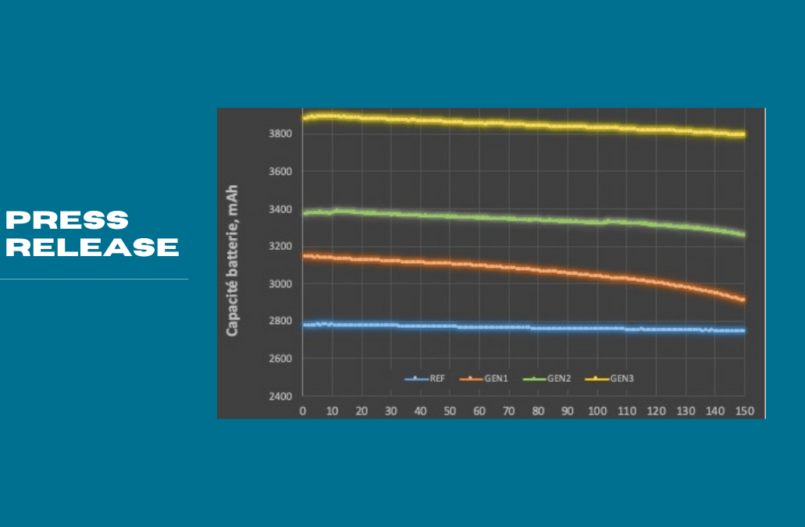- 18650 batteries with GEN3 silicon-based materials continue to outperform commercially available graphite batteries by approximately 39%, GEN1 by over 30%, and GEN2 by over 16%, all with only a 2% capacity degradation [1] after 150 cycles.
MONTREAL, Canada — HPQ Silicon Inc. (“HPQ” or the “Company”) (TSX-V: HPQ) (OTCQB: HPQFF) (FRA: O08), a technology company specializing in green engineering of silica and silicon-based materials, is pleased to update shareholders on the latest battery milestones achieved by its France-based affiliate, NOVACIUM SAS (“Novacium”).
This latest update confirms the ongoing positive trend observed since the start of the charge-discharge cycle tests on Lithium-ion 18650 batteries made using a blend of graphite and Novacium’s GEN3 silicon-based anode material. The tests demonstrate an approximate 39% overall capacity improvement compared to the graphite benchmark after 150 cycles under conditions simulating real-world usage [2]. Additionally, after 150 cycles, the battery performance is 30% higher than the previous GEN1 material and 16% higher than that of the GEN2 material, with a 2% capacity degradation compared to the graphite benchmark 1% capacity degradation.
“These results continue to confirm our unique position as one of the only producers of advanced silicon anode material that can deliver superior 18650 high-performance batteries,” said Dr. Jed Kraiem, COO of Novacium. “The ability to get these results with our proprietary silicon material under real-world conditions further validates our capabilities and expertise in the domain.”
ENHANCING BATTERY PERFORMANCE WITH SILICON-BASED ANODE MATERIALS
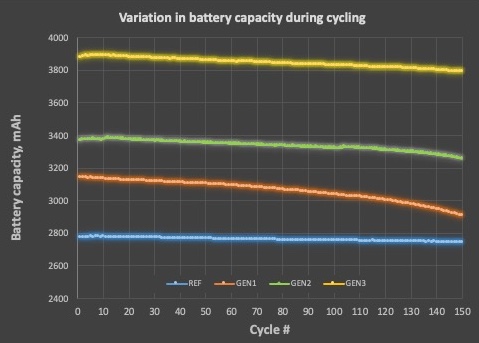
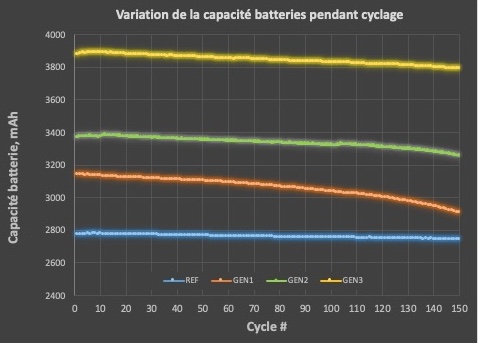
Graph 1 shows the battery capacity (in mAh) of 18650 batteries made with Novacium GEN3 (yellow line), GEN2 (green line), GEN1 (orange line) materials, and a 100% graphite benchmark (blue line) over 150 cycles. At 150 cycles, the GEN3 batteries maintain an average capacity of 3,793 mAh, outperforming GEN2 at 3,257 mAh, GEN1 at 2,910 mAh, and the graphite benchmark at 2,748 mAh.
This data highlights that GEN3 silicon-based batteries offer approximately 39% more capacity than the graphite benchmark, 30% more than GEN1, and 16% more than GEN2 after 150 cycles.
SILICON-BASED ANODE MATERIALS WITH GRAPHITE-LIKE DEGRADATION AT 150 CYCLES
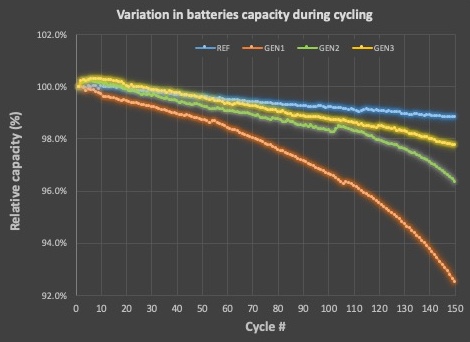
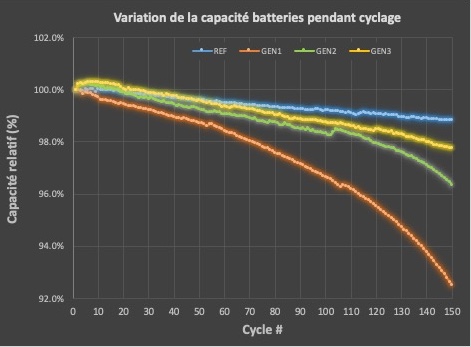
Graph 2 demonstrates the minimal performance degradation for GEN3 advanced silicon material over 150 cycles, with a capacity retention of 97.8% compared to 98.8% for the graphite benchmark— a difference of 1.0%. Specifically, the absolute capacity of the GEN3 batteries (yellow line) decreased from 3,883 mAh to 3,793 mAh. In comparison, GEN2 batteries (green line) retained 96.3% of its capacity, dropping from 3,370 mAh to 3,257 mAh, while GEN1 batteries (orange line) retained only 92.5% of its capacity, decreasing from 3,145 mAh to 2,910 mAh. The graphite benchmark (blue line) showed a slight decline from 2,780 mAh to 2,748 mAh, retaining 98.8% capacity.
Graph 2 further illustrates that between 100 and 150 cycles, batteries using the graphite benchmark experienced a 0.4% degradation in capacity (from 99.2% to 98%), while batteries made with Novacium GEN3 materials showed a 1% degradation (from 98.8% to 97.8%), a result comparable to graphite performance. By comparison, batteries made with Novacium GEN2 materials experienced a 2% degradation (from 98.3% to 96.3%), while those made with GEN1 materials showed a 4.2% degradation (from 96.7% to 92.5%).
“GEN3’s capacity retention of 97.8%, reflecting a minimal 2.2% capacity loss after 150 cycles, represents a significant achievement. This is especially notable when compared to commercially available high-performance (>3,000 mAh) 18650 battery models, which lose between 11% and 20% of their capacity after the same number of cycles, depending on the model [3],” said Bernard Tourillon, President and CEO of HPQ Silicon Inc. and NOVACIUM SAS. “These results have real-world implications, as our material can be integrated seamlessly into existing manufacturing processes without the need for costly retooling or overhauls.”
REFERENCE SOURCES
[1] Novacium technical team analysis of the data from the ongoing charging and discharging cycle tests conducted at a world-leading university, the name of which is kept confidential for competitive reasons.
[2] Cycling parameters from: Ratnakumar Bugga et al. “Performance of Commercial High Energy and High Power Li-Ion Cells in Jovian Missions Encountering High Radiation Environments”, NASA Battery Workshop November 19-21, 2019.
[3] Link to the source of the information on NCR18650G-datasheet-specifications-Panasonic, and, Link to the source of the Samsung INR18650-35E Battery capacity graph.
About NOVACIUM SAS
Novacium is an HPQ – affiliated company that started in Q3 2022. This green technology startup is based in Lyon, France and is a partnership with HPQ and three of France’s leading research engineers, Dr. Jed KRAIEM PhD, Novacium’s Chief Operating Officer (“COO”), Dr. Oleksiy NICHIPORUK PhD, Novacium’s Chief Technical Officer (“CTO”), and Dr. Julien DEGOULANGE PhD, Novacium’s Chief Innovation Officer (“CIO”). Novacium is a new Research and Development company which allows researchers to develop their own technology in high-added-value fields connected to renewable energy and allows HPQ Silicon Inc. a Canadian company, to expand the depth and reach of its technical team to help develop its silicon and new renewable energy projects.

